Best Supply Chain Intelligence Software for Smarter Decision Making

Supply chain intelligence is finally gaining the momentum and visibility it deserves. In 2023, Gartner released a comprehensive market guide for analytics and decision intelligence platforms in the supply chain, marking a decisive shift in industry thinking.
Why is supply chain intelligence now recognized as a major breakthrough?
The answer is clear: analytics and AI-powered intelligence significantly enhance decision-making capabilities in the supply chain. Historically, the industry focused mainly on achieving end-to-end visibility, with less emphasis on leveraging this visibility for semi- or fully automated decision-making. While some tools offered decision support, the full potential of decision augmentation and automation was just beginning to unfold.
Now, supply chain intelligence is effectively bridging this gap, transforming decision-making processes and influencing the industry’s future direction.
Interested in learning more about Decision Intelligence? Check out our blog on AI-powered Supply Chain Decision Intelligence.
Ready to explore the best supply chain intelligence software available? Dive right in.
Best Supply Chain Intelligence Software in 2025
The best supply chain intelligence software in the market right now are:
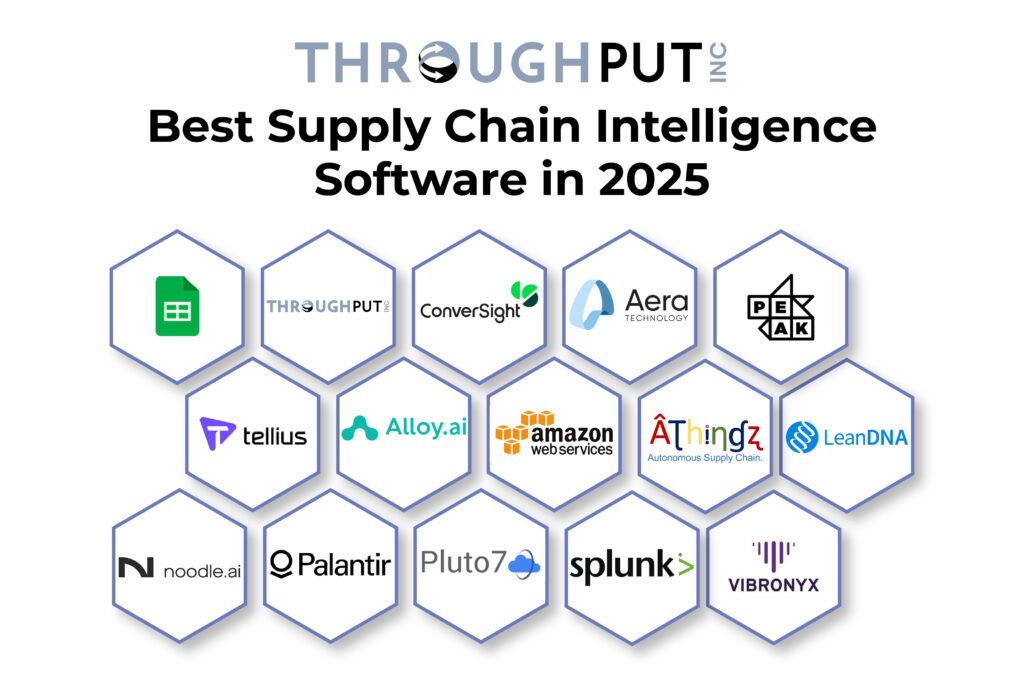
- Spreadsheets (Make no conclusions until you read our perspective below!)
- ThroughPut AI
- Conversight
- Aera Technology
- Peak.AI
- Tellius
- Alloy.ai
- Amazon Web Services
- aThingz
- LeanDNA
- Noodle.ai
- Palantir
- Pluto7
- Splunk
- Vibronyx
Let’s take a closer look at each one.
1. Spreadsheets!!!
First things first: spreadsheets are not decision intelligence tools.
The mention of spreadsheets here serves as a reminder to move beyond their familiar confines. Today’s market offers a plethora of innovative, new-age solutions that far surpass the capabilities of traditional spreadsheets.
While spreadsheets might be adequate for businesses operating in a single location with a limited range of products, they fall short for rapidly expanding businesses facing the complexities of a growing ecosystem.
As your business scales and diversifies, the need for robust and scalable decision intelligence tools becomes critical. These tools provide strategic insights through real-time data analytics and predictive modeling—capabilities far beyond what any spreadsheet can offer.
2. ThroughPut AI
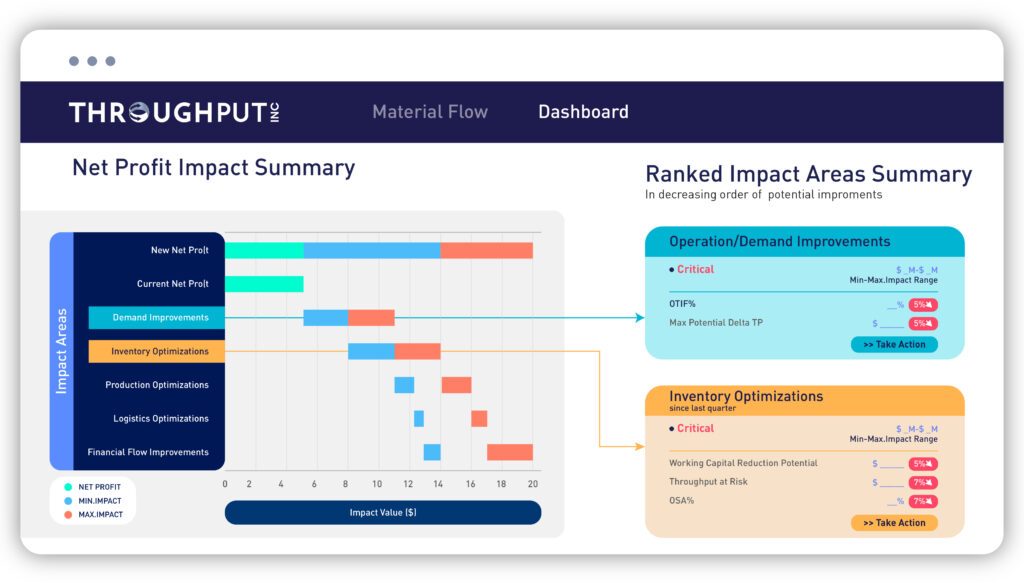
Watch On-demand Demo
One of the top supply chain intelligence software solutions, recognized in the prestigious 2023 Gartner market guide, ThroughPut AI leverages artificial intelligence and advanced analytics to optimize supply chain operations.
This tool provides actionable insights and recommendations, helping to streamline business processes and reduce waste, bottlenecks, and inefficiencies, all while demonstrating a significant impact on the bottom line.
It utilizes real-time and near-term data across the supply chain to recommend solutions and enhance decision-making capabilities, enabling businesses to operate more efficiently and effectively.
Main Features
- Identify the area with the fastest and most improvement potential
- A comprehensive net profit overview to help businesses understand the financial outcomes of optimized supply chain operations
- Works with existing data using APIs, Excel and CSV file uploads
- Real-time decision-making enabled by a unified data hub that offers complete visibility from upstream to downstream operations
- Advanced cognitive analytics powered by AI and machine learning
Main Benefits
- Access to non-technical users
- Faster ROI in less than 90 days
- Scalable and adaptable to various business needs
- Improvements in on-time in-full (OTIF) delivery and free cash flow
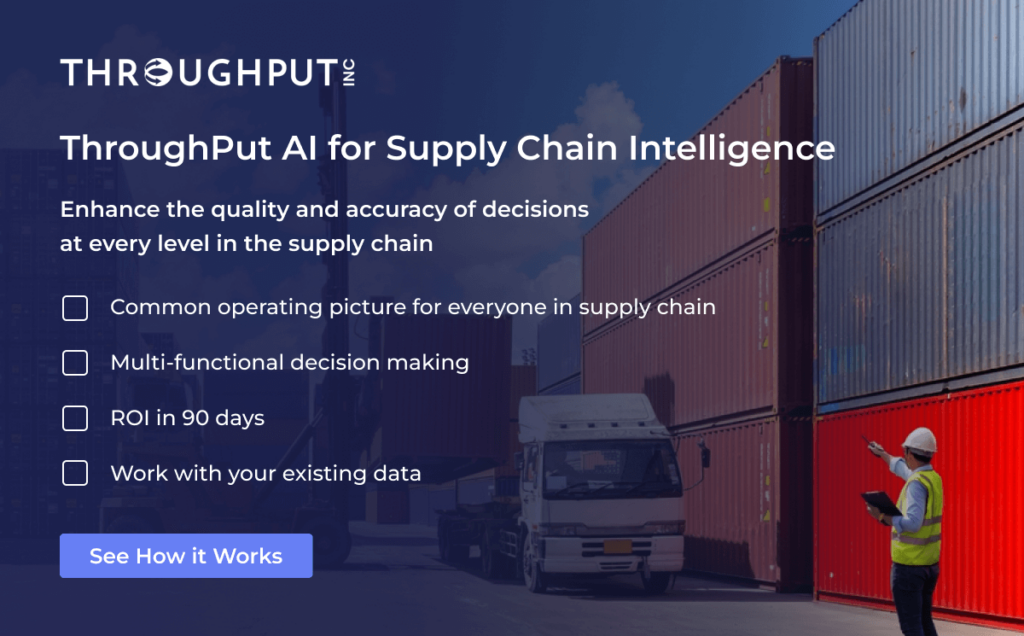
3. Conversight
It is a leading supply chain intelligence software with a focus on operational efficiency and strategic decision-making. It works with AI, machine learning, and predictive analytics to offer real-time insights.
Main Features
- Tracks supply chain activities in real time
- Anticipates demand fluctuations, supply disruptions, and other potential challenges
- An intuitive dashboard to visualize data and access critical information.
- Conversight integrates with existing ERP and other supply chain management systems
Main Benefits
- Provides real-time insights helping in more informed and strategic decision-making
- The tool identifies inefficiencies and optimizes processes leading to significant improvements in operational efficiency
- Costly disruptions and overstock situations are prevented, contributing to substantial cost savings
- The software is scalable and grows with your business without compromising performance
4. Aera Technology
Aera Technology works with cognitive automation for transformative supply chain operations. With the integration of AI, machine learning, and real-time analytics, Aera offers actionable insights and automated decision-making capabilities.
Main Features
- Cognitive automation for informed and timely decisions
- Continuous analysis of real-time data
- Advanced algorithms to forecast future trends and potential disruptions
Main Benefits
- Identifies and addresses inefficiencies, leading to streamlined operations and reduced operational costs
- Businesses can strategize risk management strategies minimizing the impact of disruptions on the supply chain
5. Peak.AI
Designed to leverage the advantages of artificial intelligence, Peak.AI facilitates optimized decision-making with actionable insights. Businesses that use this comprehensive suite of tools benefit from agile supply chains that meet the diverse needs of their businesses.
Main Features
- Advanced AI algorithms to analyze supply chain data
- Predictive analytics to forecast demand, identify potential disruptions and optimize inventory levels
- Real-time monitoring and reporting
Main Benefits
- AI-driven insights facilitate informed and strategic decisions
- Streamline operations and reduce costs by identifying inefficiencies and optimizing processes
- Scalable to support a business as it grows
6. Tellius
Another tool on the list of the best supply chain intelligence software in 2025 is Tellius. Working with AI and advanced analytics, the tool helps drive operational efficiency and excellence. Tellius simplifies complex data analysis, offering businesses valuable and practical insights for improved decision-making, converting your supply chain into an agile and efficient system.
Main Features
- Analyzes large volumes of supply chain data
- Interacts with users using natural language queries
- Provides up-to-date information on supply chain performance
- Customizable dashboards to visualize key metrics and track performance indicators
Main Benefits
- More accurate and strategic decisions, improving overall supply chain effectiveness
- Streamlined operations and cost reductions help identify inefficiencies and provide actionable recommendations
- Accessible to users from all technical backgrounds, and easy to adopt across the organization
7. Alloy.ai
Ammoy.ai is one of the best supply chain intelligence software systems designed to facilitate data-driven decisions for brands and manufacturers.
It connects with multiple data sources and real-time POS from retailers, e-commerce sites, 3PLs, distributors, data warehouses, lakes, ERP systems, and Business Intelligence & Planning applications for predictive analytics to enhance decision-making and respond promptly.
Main Features
- Real-time visualization and analytics of supply chain, inventory and sales
- Predictive demand and retail analytics
- Integrated internal and external data from sales and inventory
Main Benefits
- New sales opportunities can be identified with alerts to potential issues
- A single source of truth can be created with integrated data into data warehouses like Snowflake, BigQuery, etc.
- Boosts supply chain responsiveness
8. Amazon Web Services (AWS)
AWS has a comprehensive range of 200 fully featured services. The cloud-based solutions offered by AWS help streamline supply chain operations.
Main Features
- Data integration from various sources especially the AWS Partner Network
Main Benefits
- Ready-to-use analytical tools for pattern identification and inventory optimization
- Multi-regional support
9. aThingz
Another Gartner-recognized partner, aThingz is a supply chain optimization platform representing the 4 I’s – Intelligent, Innovative, Intuitive, and Integrated.
Main Features
- Multiple systems synced simultaneously for planning, execution, and performance management
- Predictive analytics for logistics
Main Benefits
- Reduces operational disruptions
- Enhances decision-making with real-time insights
- Significant improvement in productivity
10. LeanDNA
This is another top supply chain intelligence platform for better on-time delivery. It helps achieve production readiness and inventory excellence.
Main Features
- Automated inventory analytics
- Production performance dashboards
- 90+ validation tests
Main Benefits
- Improvement in on-time delivery
- Significant critical shortage reduction
- Improved inventory turns and timelines
11. Noodle.ai
The tool uses AI/ML techniques and data science for better demand forecasting across all hierarchical levels. It is a platform that boosts supply chain intelligence by eliminating human bias, minimizing risks, and improving operational efficiency.
Main Features
- Analyzing data and signals along with historical shipments and orders
- Risk mitigation algorithms
- Predictive analytics for inventory and demand
Main Benefits
- Bias reduction across product, geography, and time
- Enhances production efficiency
- Lowers costs through predictive planning
12. Palantir
Made robust with cutting-edge data integration and analytics, Palantir facilitates AI-based decision advantage with data integration and analytics. The tool offers real-time insights and end-to-end transparency helping empower your supply chains.
Main Features
- Full stack interoperability
- Real-time supply chain monitoring
- Multi-layered security & data privacy
Main Benefits
- Increases transparency in the supply chain
- Improves decision-making with real-time data
- Strengthens operational resilience
13. Pluto7
Pluto7 leverages AI and machine learning to optimize supply chain operations. The tool integrates 250+ data sources. It helps drive better profitability and supply chain efficiency while facilitating demand forecasting, and inventory management.
Main Features
- AI-powered planning and demand forecasting anytime and anywhere
- End-to-end visibility for streamlined business operations
- Connecting supply chain with sales, marketing, and external data with advanced AI and Gen AI.
Main Benefits
- Agile supply chain
- Reduces inventory costs
- Improves forecast accuracy
14. Splunk
Cisco-acquired, Splunk is a robust data analytics platform that helps deliver resilience across the supply chain, and their overall digital footprint. Companies can optimize their supply chain operations and secure their mission-critical systems with Splunk by converting machine data into actionable insights.
Main Features
- Real-time data analytics and actionable insights
- Customizable dashboards
- Machine learning integration
- Automated investigations and response
Main Benefits
- Enhances operational visibility
- Enables proactive issue detection
- Increases supply chain efficiency
15. Vibronyx
The platform uses AI and data analytics for successful supply chain transformations to optimize performance and minimize disruptions across the chain. It uses data to build resilience and deliver enhanced visibility across global networks, helping companies leverage intelligent decision-making.
Main Features
- Predictive analytics for disruption prevention
- Data integration from multiple sources
Main Benefits
- Provides comprehensive visibility across the network
- Reduces supply chain risks
- Increases operational efficiency
Now that you know about the top supply chain intelligence software in the market right now, here are a few more things you need to know.
What (Exactly!) is a Supply Chain Intelligence Software?
Supply chain decision intelligence software harnesses data to empower companies to make faster, smarter, and more profitable decisions at scale and in real time. This approach drives operational efficiency and significantly enhances overall business performance.
By leveraging supply chain decision intelligence, you can accelerate your decision-making processes while optimizing outcomes, ensuring you meet and exceed operational and financial objectives.
Why Do Businesses Need Supply Chain Intelligence Software Today?
Supply chain intelligence software is suddenly a topic of discussion in supply chain circles. And that’s because this tool promises to help you navigate the complexities and challenges of the modern supply chain. Here’s why it has become particularly essential:
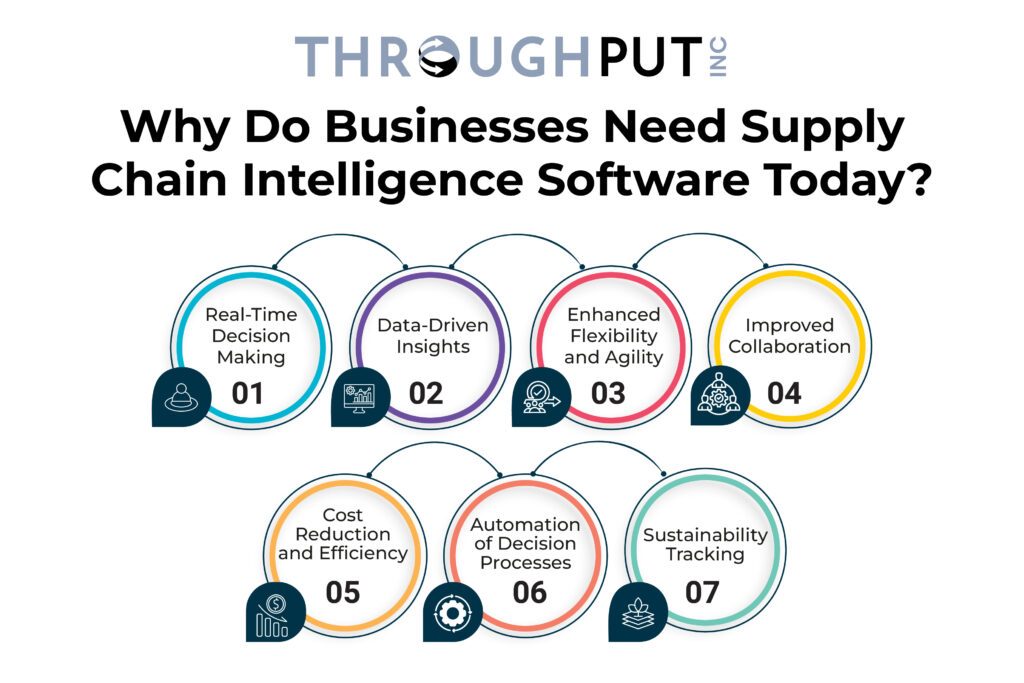
- Real-Time Decision Making
As disruptions become more frequent and markets constantly evolve, you need to make timely decisions based on near-instant insights. A supply chain intelligence software offers real-time data access, enabling cross-functional teams to react quickly and mitigate risks.
For example, a sudden shortage of raw materials can be addressed immediately by adjusting procurement strategies, avoiding costly production delays.
- Data-Driven Insights
Supply chains have large amount of data. These when left unchecked, can overwhelm decision-makers. A supply chain intelligence software system applies advanced analytics to uncover patterns, forecast trends, and offer prescriptive solutions using this data.
For instance, by analyzing historical sales data and external market indicators, the software can predict demand spikes and suggest inventory adjustments, ensuring supply meets demand efficiently.
- Enhanced Flexibility and Agility
Supply chain intelligence software lets you stay agile by offering real-time scenario analysis and forecasting capabilities. If a geopolitical event disrupts global shipping routes, the software can quickly recommend rerouting of shipments or suggest alternative suppliers, minimizing operational impact.
- Improved Collaboration
Supply chain operations often involve multiple departments working in silos. Supply chain intelligence software unifies data and provides a shared platform for all stakeholders, fostering collaboration.
For example, marketing, procurement, and logistics teams can collaborate seamlessly on promotional campaigns, ensuring sufficient stock levels and timely deliveries.
- Cost Reduction and Efficiency
Optimizing supply chain processes leads to significant cost savings. The software helps you improve demand forecasting, reduce inventory carrying costs, and eliminate waste.
For instance, better visibility into production schedules and inventory levels allows companies to avoid overproduction or stockouts, resulting in cost-efficient operations.
- Automation of Decision Processes
AI and machine learning integrated into supply chain intelligence software automate data analysis and streamline decision-making. This reduces reliance on manual processes. Businesses can speed up the time required to generate actionable insights.
- Sustainability Tracking
As sustainability becomes a corporate imperative, supply chain intelligence software assists businesses in monitoring and improving their environmental impact. By tracking carbon emissions, optimizing transportation routes, and reducing waste, you not only comply with regulatory standards but also enhance your brand reputation among eco-conscious consumers.
How Supply Chain Intelligence Software Enhances Decision-Making?
Supply chain intelligence software enhances decision-making by integrating real-time data with advanced analytics, helping you to swiftly respond to disruptions. By pulling data from diverse sources like sales, inventory, logistics, and other external sources the software offers comprehensive, contextualized insights that drive informed decisions across the supply chain. For example, it can anticipate a supplier’s delay and recommend alternate sourcing options for you, preventing production slowdowns.
This capability is especially important as businesses rely more on predictive and prescriptive analytics to forecast future trends and weigh potential outcomes. By evaluating scenarios — such as predicting demand surges during peak seasons — the software helps companies proactively adjust strategies, ensuring operational efficiency.
The software also fosters collaboration by providing a unified platform for cross-functional teams to share insights and make decisions collectively. Automation reduces manual inputs, eliminates human biases, and accelerates decision processes, while data visualization tools present complex information in an easily digestible format. With these insights, organizations can respond with more agility, reduce inefficiencies, and ultimately achieve superior business outcomes, reinforcing their competitive edge.
That brings us to a question we hear often.
How to Choose the Best Supply Chain Intelligence Software for Your Business?
Selecting the right supply chain intelligence software for your business requires a thoughtful approach. That’s because the software needs to align with your operational needs and strategic objectives.
- Begin by evaluating the software’s integration capabilities. It must seamlessly connect with your current systems to enable real-time data processing and analytics. For example, if your business relies heavily on ERP or CRM systems, the software should integrate smoothly to provide holistic insights.
- Next, assess the software’s analytics features, focusing on predictive and prescriptive capabilities that deliver actionable insights. Look for platforms with robust data visualization tools and natural language processing (NLP), which make complex data more accessible to diverse team members.
- Scalability is another crucial factor. Choose software that can grow alongside your business and adapt to evolving needs. Engage stakeholders from IT and business units to define clear use cases and specific requirements, ensuring the software supports your decision-making scenarios.
- Finally, evaluate the vendor’s support and training offerings to ensure smooth implementation, user adoption, and long-term success.
What Features Should You Look for in Supply Chain Intelligence Software?
Choosing the right supply chain intelligence software requires careful evaluation of its features to ensure it meets your business’s unique needs.
Below are key features to prioritize:
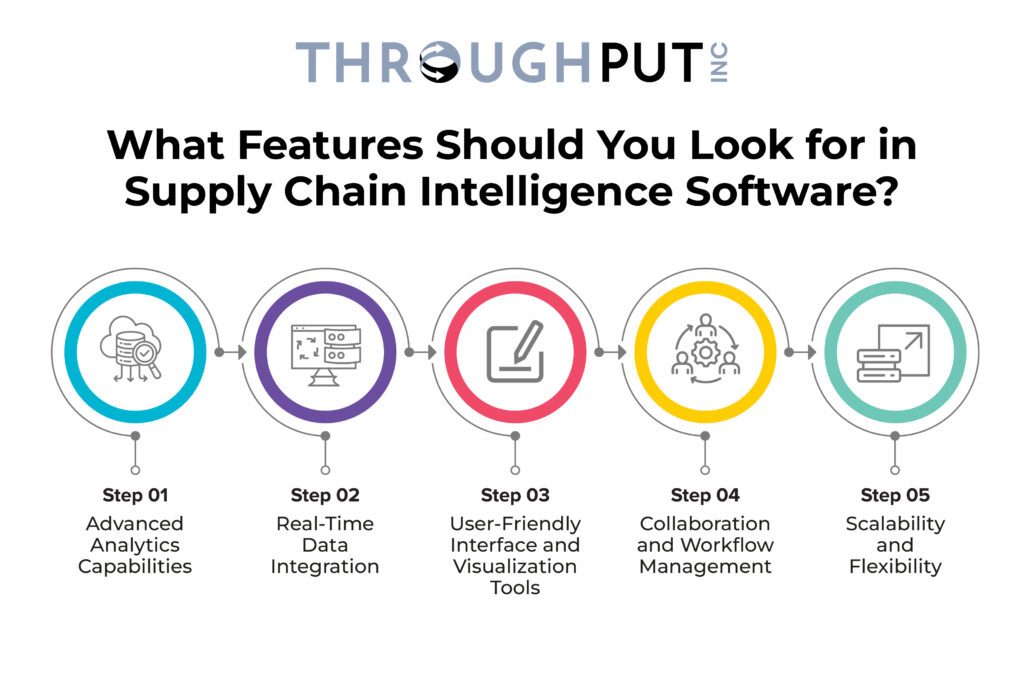
Advanced Analytics Capabilities
Look for a system that offers predictive and prescriptive analytics powered by machine learning. It analyzes historical data and models future scenarios, helping you make informed, data-driven decisions. For example, in manufacturing, predictive analytics can forecast raw material needs, reducing the risk of overstocking or stockouts.
Real-Time Data Integration
The ability to process and integrate real-time data from multiple sources is essential. This ensures that decision-makers have immediate access to current information, enabling quick responses to supply chain disruptions such as shipping delays or inventory shortages.
User-Friendly Interface and Visualization Tools
A user-friendly interface with robust data visualization tools makes complex insights more accessible. Features like customizable dashboards and natural language processing allow team members across departments to quickly interpret data and make better decisions.
Collaboration and Workflow Management
Choose a system that fosters cross-functional collaboration by enabling teams to share insights and work together on critical decisions. Workflow management tools automate repetitive tasks, increasing efficiency across departments like procurement, logistics, and finance.
Scalability and Flexibility
Ensure the software is scalable to accommodate future growth and adaptable to changing needs. As your business expands, the software should evolve to meet more complex supply chain demands, such as multi-site management or increased production volumes.
By focusing on these features, businesses can choose a solution that drives operational efficiency and supports more agile, informed decision-making.
How to Integrate Supply Chain Intelligence Software into Your Existing System?
Successfully integrating supply chain intelligence software into your current infrastructure requires a strategic approach to ensure seamless operation.
Here’s a step-by-step guide:
1. Assessment
Start by evaluating your existing systems and identifying key integration points where the new software will connect. For instance, ensure your ERP, warehouse management, and procurement systems can communicate with the new platform. Map out the data sources and workflows to be aligned.
2. Planning
Develop a detailed integration plan outlining timelines, resource allocation, and critical milestones. Involve key stakeholders from various departments, such as logistics, IT, and finance, to ensure all operational needs are addressed.
3. Data Migration
Accurately migrating data is essential. Establish clear data governance policies to ensure data quality and consistency throughout the process. For example, verify that all historical sales and inventory data are correctly transferred and standardized.
4. Testing
Conduct rigorous testing to ensure system compatibility and functionality. Test multiple scenarios, including standard operations and disruptions like supply chain delays, to confirm the system performs as expected under various conditions.
5. Training
Provide thorough training to your team on how to effectively use the new software. Employees should be well-versed in utilizing advanced features such as predictive analytics and data visualization tools to optimize supply chain operations.
6. Continuous Improvement
After integration, regularly review system performance and gather user feedback. Identify areas for continuous improvement and refine workflows to fully leverage the software’s capabilities.
By following these steps, you can ensure a smooth integration of supply chain intelligence software, leading to improved decision-making, operational efficiency, and overall supply chain performance.
Optimize Your Supply Chain with ThroughPut AI
ThroughPut AI is an AI-driven supply chain decision intelligence tool distinguished by its comprehensive capabilities. It assists supply chain managers in prioritizing decisions based on their potential impacts and seamlessly integrates these decisions with the organization’s overall profitability goals. The tool effectively utilizes existing data infrastructure and offers customization options to align with specific business requirements, significantly accelerating ROI—potentially increasing it by up to five times. This enables organizations to surpass traditional decision-making limitations and enhance operational efficiency.
We recommend trying ThroughPut AI for your supply chain intelligence needs. As the creators of this tool, we believe in its benefits, and an evaluation will likely demonstrate its value to you without any risk.
FAQs
- What industries benefit most from supply chain intelligence software?
Industries with complex and dynamic supply chains, such as manufacturing, retail, logistics, food & beverage, building materials, and military, gain significant value from supply chain intelligence software. These sectors rely on real-time insights to manage resources efficiently, reduce waste, and optimize delivery timelines.
- Why supply chain intelligence software reduces costs and boosts efficiency?
Supply Chain Intelligence Software reduces costs by optimizing inventory management, improving demand forecasting, and minimizing waste through more accurate resource allocation. For instance, a retail company can use this software to better predict seasonal demand, ensuring they stock the right amount of inventory while avoiding unnecessary storage costs. Additionally, improved visibility into supply chain operations allows businesses to streamline processes, further reducing operational costs and enhancing overall efficiency.
- How to choose the best supply chain intelligence software for your business?
When selecting the right supply chain intelligence software for your organization, consider the following critical factors:
- Delivery Model
Evaluate whether an on-premise or hosted solution is the best fit for your business. On-premise software offers more control and customization, while SaaS models (Software as a Service) provide flexibility, lower upfront costs, and easier scalability.
- Pricing Model
Analyze the pricing structure carefully. Subscription-based models are scalable and offer flexibility but assess any additional fees for features, support, or storage. Volume discounts or combination value packages can also be beneficial for businesses with large data sets or multiple sites.
- Coverage of Business Processes
Ensure the software covers essential processes like data quality management, inventory control, demand forecasting, and sustainability tracking. Comprehensive coverage ensures that the solution can address supply chain challenges from end to end, improving efficiency across the board.
- Key Challenges in Integrating Supply Chain Intelligence Software
- Data Integration and Quality
A common challenge is the integration of data from various sources, including legacy systems, cloud platforms, and third-party applications. Ensuring high-quality, consistent data is crucial, as poor data can lead to inaccurate insights. Organizations should invest in data governance policies to maintain data integrity.
- Complexity of Existing Systems
Many businesses operate in complex, fragmented IT environments. Successfully integrating new software requires careful planning to avoid operational disruptions. For example, integrating a new analytics platform with an existing ERP system can be challenging without proper support from IT.
- Resistance to Change
Successful software adoption can be cumbersome with resistance to change. Employees may be accustomed to existing processes, and introducing a new system requires comprehensive change management strategies, including targeted training and open communication. Ensuring users understand the benefits of the new system will aid in its acceptance.
- Skill Gaps
Many organizations face a shortage of personnel skilled in both supply chain management and the technical aspects of new software. Addressing these skill gaps through training programs or hiring specialized talent is essential for maximizing the software’s potential.
- Vendor Lock-In
Relying on just one vendor for your supply chain intelligence needs can be risky. If the vendor’s offerings fail to evolve with your business needs or industry trends, it may become difficult to transition to another provider. Carefully evaluate vendors to mitigate long-term risks.
- Regulatory Compliance
Businesses in highly regulated sectors, such as healthcare or finance, must ensure their supply chain intelligence solutions comply with relevant industry standards. Failure to do so can result in hefty fines or legal penalties. Be sure to choose a solution that integrates regulatory compliance tools and auditing capabilities.

